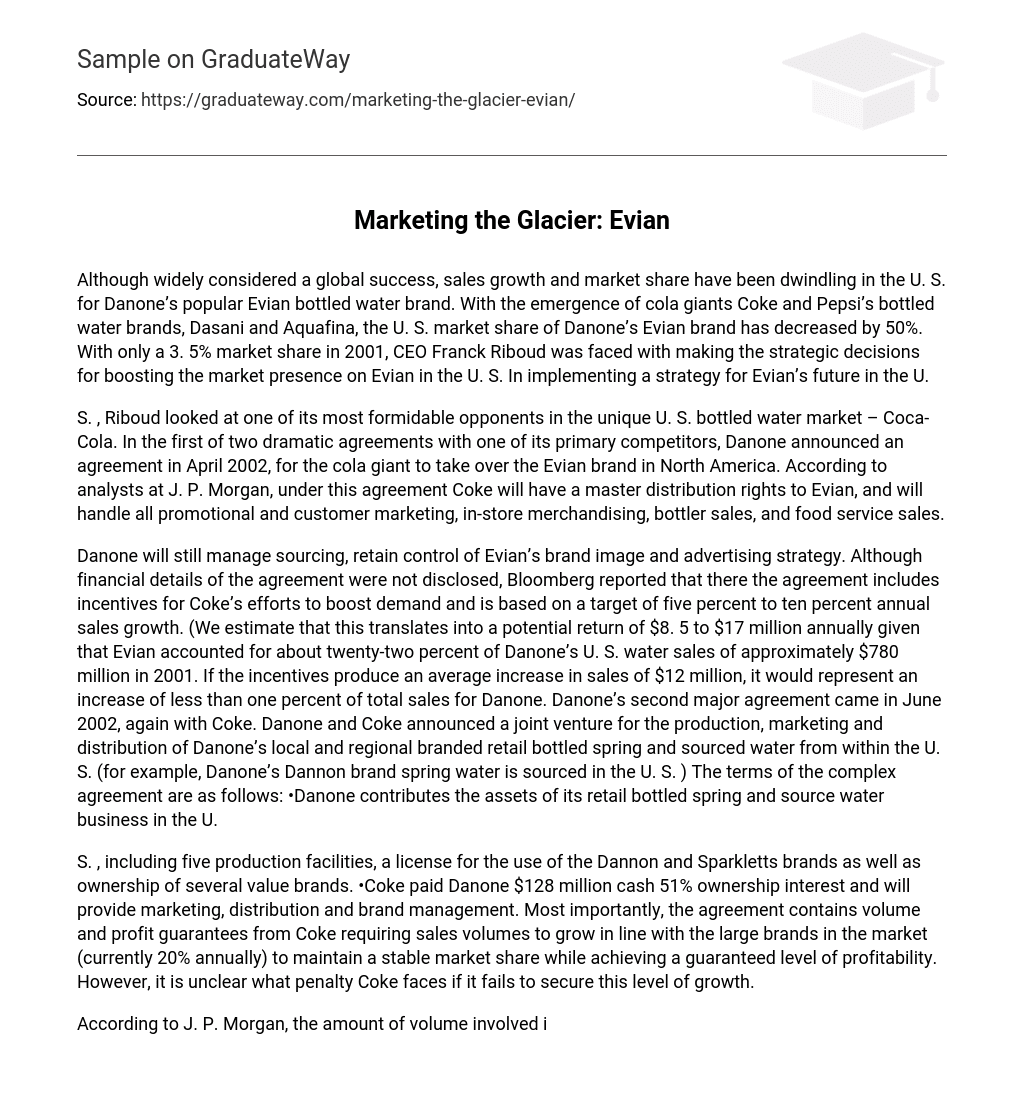Despite its global success, Danone’s Evian bottled water brand has experienced a decline in sales growth and market share in the U.S. The entry of competing bottled water brands from cola giants Coke and Pepsi, such as Dasani and Aquafina, has caused Danone’s Evian brand to lose 50% of its market share in the U.S.
In 2001, CEO Franck Riboud prioritized improving Evian’s market presence in the U.S., as it only held a 3.5% market share. Thus, enhancing Evian’s future in the U.S. became Riboud’s top priority.
S. Riboud examined the competition from Coca-Cola in the specific market of bottled water in the United States. In an unprecedented move, Danone announced a partnership with this major competitor in April 2002, which granted Coke control over the Evian brand in North America. Analysts from J.P. Morgan stated that this agreement gives Coke exclusive privileges for distributing Evian, encompassing tasks such as promotions, customer marketing, in-store displays, sales through bottlers and food service establishments.
The financial details of the agreement between Danone and Evian were not disclosed. However, Bloomberg reported that Coke has incentives to increase demand based on a target of 5-10% annual sales growth. This could potentially result in a yearly return of $8.5 to $17 million. In 2001, Evian accounted for around 22% of Danone’s U.S. water sales which amounted to approximately $780 million. If the incentives lead to an average sales increase of $12 million, it would represent less than 1% of Danone’s total sales.
In June 2002, Danone also entered into another significant agreement with Coke involving the production, marketing, and distribution of their own branded retail bottled spring and sourced water within the U.S. For example, Danone’s Dannon brand sources its spring water domestically. The terms of this complex agreement are as follows: Danone contributes their retail bottled spring and source water assets in the U.S.
S., including five production facilities, a license for the use of the Dannon and Sparkletts brands, and ownership of several value brands. Furthermore, Coke paid Danone $128 million in cash for a 51% ownership interest and will provide marketing, distribution, and brand management. The agreement is particularly important as it includes volume and profit guarantees from Coke, which require sales volumes to grow in line with the market’s large brands (currently growing at a rate of 20% annually). This ensures a stable market share and guarantees a certain level of profitability. However, it remains uncertain what consequences Coke will face if it fails to achieve this growth target.
J. P. Morgan states that the volume involved is 135 million cases and predicts that the joint venture could generate revenues in the $200 million dollar range. The three main obstacles for Danone in gaining market share in the U.S. are the consumer’s lack of preference for specific water types, challenges in entering cola-controlled distribution systems, and price-sensitivity towards bottled water. In Europe, consumers are more knowledgeable about different types of bottled water and are willing to pay a premium for the Evian brand due to the high transportation costs from the French Alps to the states. Equity analyst estimates show that Evian’s average price per case is approximately 80% higher than Aquafina or Dasani. However, U.S. customers place little value on this premium and prefer to choose cheaper alternatives. Wall Street analysts have debated whether Danone’s deals with Coke will lead to growth for Evian or signal Danone’s unofficial withdrawal from the U.S. bottled water market.
The completion of the Coke joint venture may not have assured Evian’s gain in market share in the U.S. This left Riboud with many questions. How can a CEO deny the need for the U.S. market but still proceed with a major deal in that same market months later? Will the partnership with Coke guarantee success for Danone and Evian? Was this deal a desperate move? Could Danone have pursued a U.S. market strategy independently? How should a CEO handle rumors of future mergers with U.S. food giants like Kraft, in order to create a truly global food services company?
Bibliography Annacchino, New Product Development: From Initial Idea to Product Management, Butterworth-Heinemann, 2003
Dalrymple, Parson, Marketing Management: Text and Cases, 7th Ed., Wiley, 2000
Huselid, Ulrich, Becker, The HR Scorecard: Linking People, Strategy and Performance, HBS Press, 2001
Koehn, Brand New: How Entrepreneurs Earned Consumer’s Trust, HBS Press, 2001
Blattberg, Getz, Thomas, Customer Equity: Building and Managing Relationships as Valuable Assets, HBS Press, 2001
Mullins, Walker, Larreche, Boyd, Marketing Management: A Strategic Decision-Making Approach, McGraw-Hill, 2004





